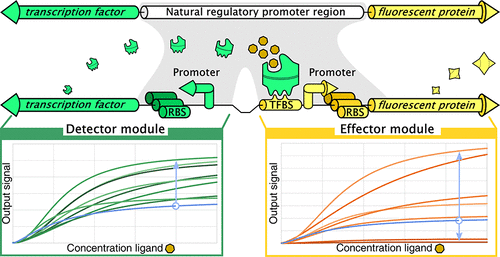当前位置:
X-MOL 学术
›
ACS Synth. Biol.
›
论文详情
Our official English website, www.x-mol.net, welcomes your
feedback! (Note: you will need to create a separate account there.)
Modularization and Response Curve Engineering of a Naringenin-Responsive Transcriptional Biosensor
ACS Synthetic Biology ( IF 3.7 ) Pub Date : 2018-04-24 00:00:00 , DOI: 10.1021/acssynbio.7b00419 Brecht De Paepe 1 , Jo Maertens 1 , Bartel Vanholme 2, 3 , Marjan De Mey 1
ACS Synthetic Biology ( IF 3.7 ) Pub Date : 2018-04-24 00:00:00 , DOI: 10.1021/acssynbio.7b00419 Brecht De Paepe 1 , Jo Maertens 1 , Bartel Vanholme 2, 3 , Marjan De Mey 1
Affiliation

|
To monitor the intra- and extracellular environment of micro-organisms and to adapt their metabolic processes accordingly, scientists are reprogramming nature’s myriad of transcriptional regulatory systems into transcriptional biosensors, which are able to detect small molecules and, in response, express specific output signals of choice. However, the naturally occurring response curve, the key characteristic of biosensor circuits, is typically not in line with the requirements for real-life biosensor applications. In this contribution, a natural LysR-type naringenin-responsive biosensor circuit is developed and characterized with Escherichia coli as host organism. Subsequently, this biosensor is dissected into a clearly defined detector and effector module without loss of functionality, and the influence of the expression levels of both modules on the biosensor response characteristics is investigated. Two collections of ten unique synthetic biosensors each are generated. Each collection demonstrates a unique diversity of response curve characteristics spanning a 128-fold change in dynamic and 2.5-fold change in operational ranges and 3-fold change in levels of Noise, fit for a wide range of applications, such as adaptive laboratory evolution, dynamic pathway control and high-throughput screening methods. The established biosensor engineering concepts, and the developed biosensor collections themselves, are of use for the future development and customization of biosensors in general, for the multitude of biosensor applications and as a compelling alternative for the commonly used LacI-, TetR- and AraC-based inducible circuits.
中文翻译:

柚皮素响应转录生物传感器的模块化和响应曲线工程。
为了监测微生物的细胞内和细胞外环境并相应地适应其代谢过程,科学家正在将自然界无数的转录调节系统重新编程为转录生物传感器,该传感器能够检测小分子,并以此来表达特定的输出信号。选择。但是,自然发生的响应曲线(生物传感器电路的关键特性)通常不符合现实生活中生物传感器应用的要求。在这一贡献中,开发了天然的LysR型柚皮素响应生物传感器电路,并用大肠杆菌进行了表征作为宿主生物。随后,将该生物传感器解剖成清晰定义的检测器和效应器模块,而不会损失功能,并且研究了两个模块的表达水平对生物传感器响应特性的影响。分别生成十个独特的合成生物传感器的两个集合。每个系列都展示了独特的响应曲线特征多样性,其动态范围变化了128倍,工作范围变化了2.5倍,噪声水平变化了3倍适用于广泛的应用,例如自适应实验室演进,动态路径控制和高通量筛选方法。既定的生物传感器工程概念以及已开发的生物传感器集合本身,通常用于未来生物传感器的开发和定制,广泛的生物传感器应用以及作为常用的LacI-,TetR-和AraC-的引人注目的替代品基于感应电路。
更新日期:2018-04-24
中文翻译:

柚皮素响应转录生物传感器的模块化和响应曲线工程。
为了监测微生物的细胞内和细胞外环境并相应地适应其代谢过程,科学家正在将自然界无数的转录调节系统重新编程为转录生物传感器,该传感器能够检测小分子,并以此来表达特定的输出信号。选择。但是,自然发生的响应曲线(生物传感器电路的关键特性)通常不符合现实生活中生物传感器应用的要求。在这一贡献中,开发了天然的LysR型柚皮素响应生物传感器电路,并用大肠杆菌进行了表征作为宿主生物。随后,将该生物传感器解剖成清晰定义的检测器和效应器模块,而不会损失功能,并且研究了两个模块的表达水平对生物传感器响应特性的影响。分别生成十个独特的合成生物传感器的两个集合。每个系列都展示了独特的响应曲线特征多样性,其动态范围变化了128倍,工作范围变化了2.5倍,噪声水平变化了3倍适用于广泛的应用,例如自适应实验室演进,动态路径控制和高通量筛选方法。既定的生物传感器工程概念以及已开发的生物传感器集合本身,通常用于未来生物传感器的开发和定制,广泛的生物传感器应用以及作为常用的LacI-,TetR-和AraC-的引人注目的替代品基于感应电路。











































 京公网安备 11010802027423号
京公网安备 11010802027423号